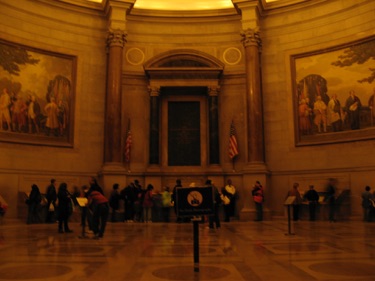Day 2
Up the next morning, we noticed the wind had picked up and the sky was still cloudy, but, thankfully, no rain was spitting. We ate our breakfast and were out the door.
Back in D.C. proper, we headed for the National Aquarium. Interestingly enough, the Aquarium is located in the basement of, and operated by, the Department of Commerce. We passed through the obligatory metal detectors.

We walked the steps to the basement and came to the entrance. Unlike every other building we entered the previous day, there was an entrance fee of five dollars. I handed the attendant my credit card. He said, “sorry, we don’t accept credit cards.” In classic government irony, the Department of Commerce would only accept one form of payment.
We entered and spent the next hour looking over different specimens from various regions of the country. It was a good aquarium, but I’ve seen many that were just as good.
After the aquarium, we made our way down to the Smithsonian Air and Space Museum. We had read earlier that this museum was the most visited museum in the world, and we were skeptical...............................until we walked in the door. The amount of people was drastically more than any of the other museums. Seeing many of the items was a challenge, but once again, they were still worth seeing.
We saw the plane that first broke the sound barrier, the Wright Brother’s plane, the plane that carried the first civilians into space, several unmanned drone aircraft, and the suits worn by Neil Armstrong and Buzz Aldrin when they landed on the moon.
The Smithsonian Museum of American History was closed for renovations, but had moved several of its items to a section of the Air and Space Museum. This section would turn out to be one of my favorites.

After a sufficient amount of time, we left the Air and Space museum and went back to the Natural History Museum. We were going back to see the Hope Diamond and the many jewels they had in their collection.
This section of museum turned out to be the most crowded section of any museum on the entire trip. It was necessary to queue to see the jewels.
We saw the Hope Diamond and were impressed. It was smaller than I expected, but it was very very glittery.

Personally, the most impressive set were the set shown to the right.
We walked and stared and walked and stared until our starers were worn out.
Finally, we came to the mineral collection. That collection was by far the most impressive and extensive collection I have ever witnessed. It seemed that every imaginable type of element was able to be viewed.
We left the Natural History Museum and walked towards the White House.
In a few minutes, we arrived on the south side and stood with the other tourists and took the obligatory photograph. I have to say, it is a pretty residence. The green lawn is a stark contrast to the white walls, but is very appealing.
We stood there and looked in that, “yep, there it is” sort of way. Then moved on west towards the Vietnam Veterans Memorial.
The Vietnam Memorial, along with the Korean Memorial, was hard for me. Unlike all other memorials around the Mall, these are a commemoration of something that isn’t a triumph of the human spirit, no shining light at the end of a tunnel, but salt in a wound that has yet to heal. It was all I could do to walk by the wall. The list of names is staggering, and one that still is unimaginable.
Personally, I can’t imagine any commander-in-chief staring at the wall and it not having an effect on foreign policy.
I can’t say that we spent much time at the Vietnam Wall.
We walked south to the Korean Memorial.

Moving on, we walked along the reflecting pool between the Lincoln Memorial and the Washington Monument. We came to the World War II monument.
This monument is oblong in nature, with columns on each corner representing each state and territory who participated in the conflict, and a fountain in the center. The north side represents the European Theater and the south side represents the Pacific Theater.
We moved back east. Our objective was the National Archives and to view the Declaration of Independence and Constitution.

To make a long story short, after a long wait to get in the building, there the Magna Carta was, in all its glory. If my memory serves me correctly, four copies were made several years after the original. This was one of those copies. We realized it was oldest document either of us had ever seen.
As we approached the main hall housing the U.S. documents, we were warned several times that no flash photography was allowed, and if you happened to let one slip, you would be escorted out of the hall.

The Declaration was a bit faded and barely legible. The Constitution was very readable.
Once again, we had to stare and stare and tell ourselves exactly what we were looking at. The gravity of the situation was overwhelming.
Dusk was settling as we walked from the building.
Another day accomplished.